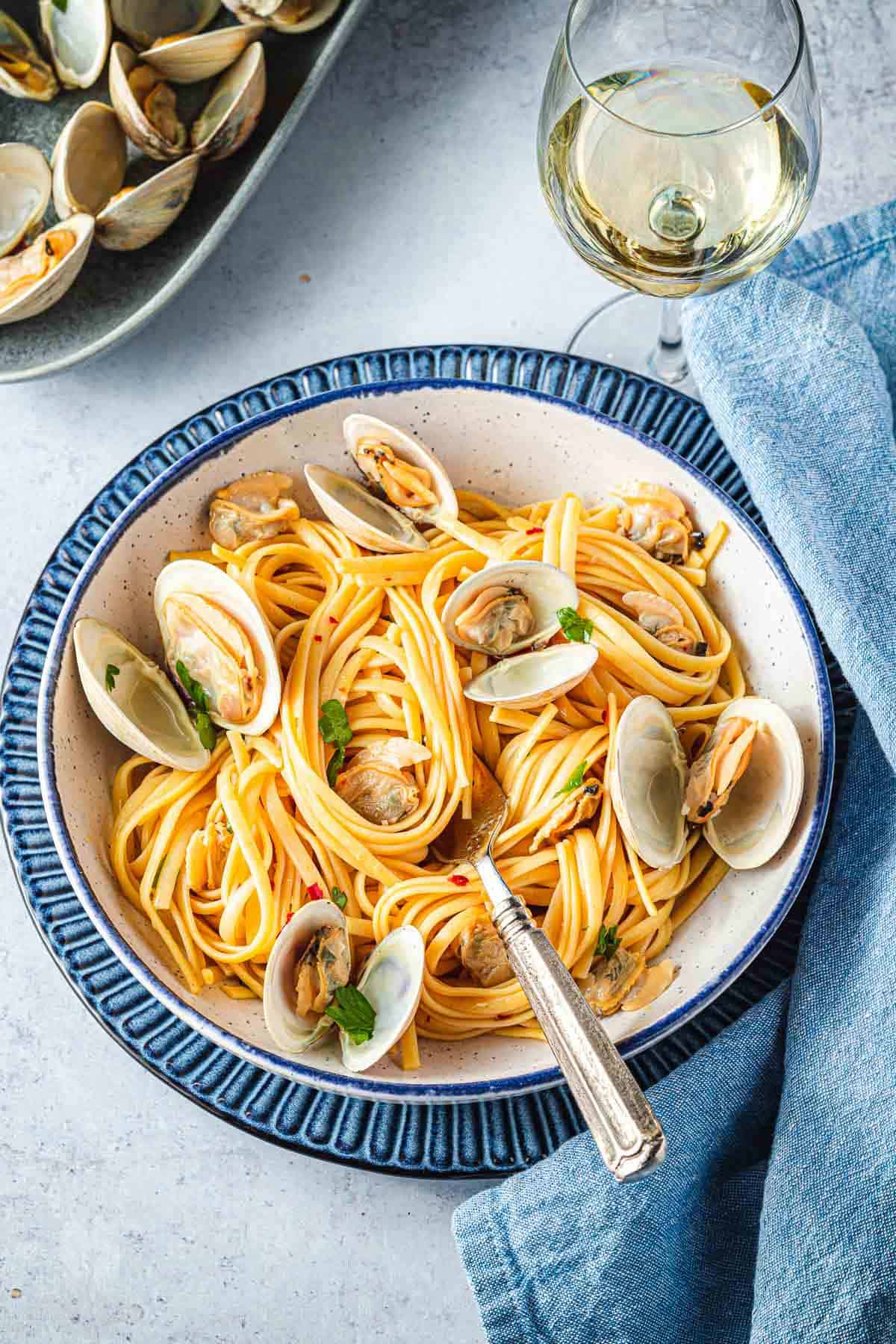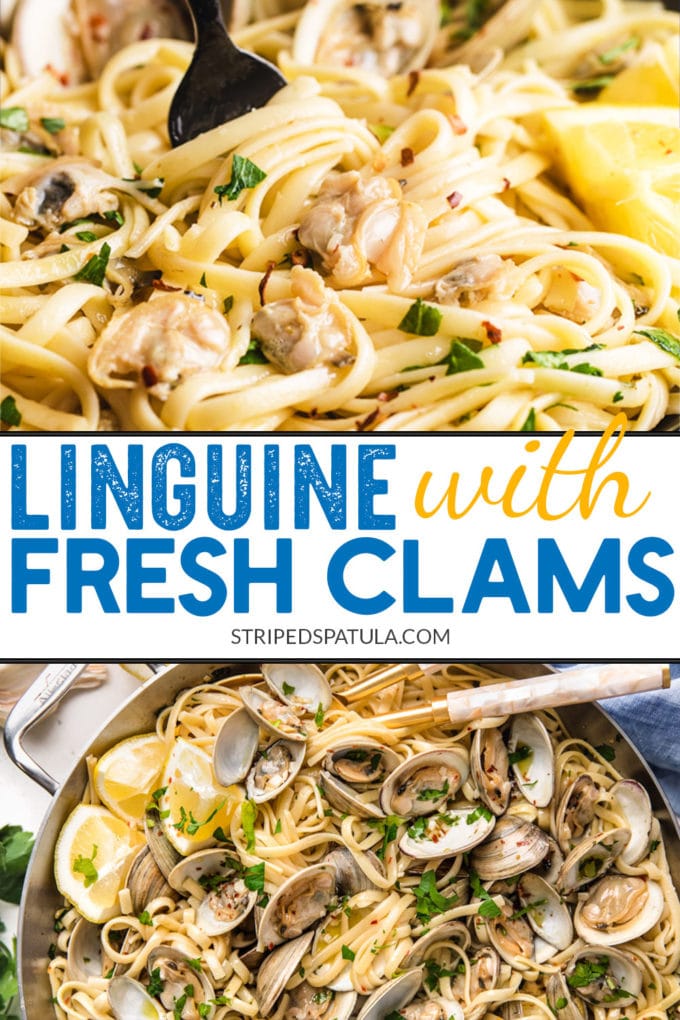Video tentang A Deep Dive into Clam Linguine: From Humble Beginnings to Culinary Icon
A Deep Dive into Clam Linguine: From Humble Beginnings to Culinary Icon

Clam linguine. The very name conjures images of sun-drenched coastal towns, the salty tang of the sea, and a comforting, deeply flavorful pasta dish. This seemingly simple combination of pasta, clams, and garlic has transcended its humble origins to become a culinary classic, beloved for its fresh, bright flavors and surprisingly easy preparation. But the seemingly straightforward nature of clam linguine belies a rich history and a surprising depth of culinary possibilities. This article will explore the history, variations, techniques, and the enduring appeal of this beloved dish.
A History Steeped in the Sea:
Pinpointing the exact origin of clam linguine is difficult. Pasta dishes featuring clams have existed in various forms across Mediterranean cultures for centuries. The use of linguine, a long, thin pasta, is a relatively modern development, gaining popularity in the 20th century. However, the fundamental elements – pasta, clams, garlic, white wine – are all hallmarks of Italian coastal cuisine, reflecting a deep-rooted tradition of utilizing readily available, fresh ingredients.
The coastal regions of Italy, particularly those in the south and along the Adriatic, have a long history of clam harvesting. Clams, being abundant and relatively easy to gather, formed a crucial part of the local diet. Early versions of clam pasta dishes likely involved simpler preparations, focusing on the natural sweetness and brininess of the clams, enhanced by herbs and perhaps a touch of olive oil. The evolution towards the now-familiar garlic, white wine, and often chili-infused sauce likely reflects a gradual refinement of techniques and the introduction of new ingredients over time.
The rise of clam linguine to its current status as a popular dish is arguably tied to the post-World War II era, a time of increased culinary exploration and the dissemination of Italian cuisine across the globe. Italian-American restaurants played a significant role in popularizing the dish, adapting it to suit American palates while retaining its core essence. The accessibility of ingredients and the relative ease of preparation further contributed to its widespread adoption.
The Essential Ingredients: A Symphony of Flavors:
The magic of clam linguine lies in the interplay of its core ingredients. Let’s delve into each one:
-
Clams: The star of the show. Littleneck clams are a popular choice, prized for their delicate flavor and relatively small size. Manila clams are another excellent option, offering a slightly sweeter taste. Regardless of the variety, freshness is paramount. Clams should be tightly closed before cooking; any that are open and don’t close when tapped should be discarded.

-
Linguine: This long, thin pasta is ideally suited for capturing the sauce and providing a pleasing textural contrast to the tender clams. Other long pasta shapes like spaghetti or fettuccine can be substituted, but linguine’s delicate nature complements the dish particularly well.

Garlic: The aromatic foundation of the sauce. Fresh garlic, minced or thinly sliced, provides a pungent yet subtle base flavor that perfectly complements the brininess of the clams.
-
White Wine: A dry white wine, such as Pinot Grigio, Sauvignon Blanc, or Vermentino, is traditionally used to deglaze the pan and add a layer of acidity that balances the richness of the clams and garlic. The wine should be of good quality, as its flavor will be prominent in the final dish.
-
Olive Oil: High-quality extra virgin olive oil is essential for both flavor and texture. It forms the base of the sauce, contributing a fruity and slightly peppery note.
-
Chili Flakes (Optional): A pinch of red pepper flakes adds a subtle kick of heat, enhancing the overall complexity of the dish. This is a matter of personal preference; those who prefer a milder flavor can omit it entirely.
-
Parsley (Optional): Freshly chopped parsley adds a touch of freshness and vibrancy, both visually and in terms of flavor. It’s often used as a garnish, sprinkled over the finished dish.
-
Lemon Juice (Optional): A squeeze of fresh lemon juice at the end brightens the flavors and adds a touch of acidity, balancing the richness of the dish.

Mastering the Technique: A Step-by-Step Guide:
While seemingly simple, the preparation of clam linguine involves a few key techniques that can elevate the dish from good to exceptional:
-
Preparing the Clams: Scrub the clams thoroughly under cold running water to remove any sand or grit. Discard any that are open and don’t close when tapped.
-
Sautéing the Garlic: Heat the olive oil in a large pan over medium heat. Add the minced garlic and sauté until fragrant but not browned, about 30 seconds to a minute. Overcooking the garlic will result in a bitter taste.
-
Adding the Clams and Wine: Add the clams to the pan and cook for a few minutes, stirring occasionally, until they begin to open. Pour in the white wine and allow it to simmer for a few minutes, allowing the alcohol to cook off and the sauce to reduce slightly.
-
Cooking the Pasta: While the clams are cooking, cook the linguine according to package directions until al dente. Reserve about ½ cup of the pasta cooking water before draining.
-
Combining and Finishing: Add the cooked linguine to the pan with the clams. Toss to coat the pasta with the sauce. If the sauce is too thick, add a little of the reserved pasta water to loosen it. Stir in the red pepper flakes (if using) and parsley (if using).
-
Serving: Serve immediately, garnished with extra parsley and a squeeze of lemon juice (if using).
Variations and Explorations:
The beauty of clam linguine lies in its adaptability. Numerous variations exist, reflecting regional differences and personal preferences:
-
Adding Vegetables: Cherry tomatoes, spinach, or zucchini can be added to the pan along with the clams, providing extra flavor and texture.
-
Creamy Clam Linguine: A splash of heavy cream or crème fraîche can be stirred into the sauce at the end for a richer, creamier version.
-
Spicy Clam Linguine: Increase the amount of red pepper flakes or add a pinch of cayenne pepper for a spicier kick.
-
White Wine vs. Broth: Some recipes substitute clam broth for some or all of the white wine, resulting in a more intensely seafood-flavored dish.
-
Herbs and Spices: Experiment with other herbs and spices, such as oregano, basil, or thyme, to add depth and complexity to the flavor profile.
Beyond the Plate: The Cultural Significance of Clam Linguine
Clam linguine isn’t just a delicious meal; it’s a reflection of cultural heritage and culinary traditions. It embodies the spirit of Italian coastal cuisine, emphasizing fresh, seasonal ingredients and simple, yet elegant preparation. The dish’s enduring popularity speaks to its ability to evoke a sense of place and time, transporting diners to sun-drenched shores and evoking memories of seaside meals shared with loved ones.
The accessibility of the ingredients and the relative ease of preparation make it a dish that can be enjoyed by home cooks of all skill levels. It’s a perfect weeknight meal, yet elegant enough to serve to guests. Its versatility allows for endless experimentation and customization, ensuring that every plate is a unique and delicious experience.
In conclusion, clam linguine is more than just a pasta dish; it’s a culinary journey, a celebration of fresh ingredients, and a testament to the enduring power of simple, yet exquisite flavors. Its enduring popularity speaks volumes about its ability to satisfy both the palate and the soul, offering a taste of the sea and a comforting sense of home. So, gather your ingredients, put on your apron, and embark on your own culinary adventure with this timeless classic. The rewards, both in taste and satisfaction, are well worth the effort.

Penutup
Therefore, we hope this article has provided valuable insights on A Deep Dive into Clam Linguine: From Humble Beginnings to Culinary Icon. We appreciate your attention to our article . See you in our next article!

